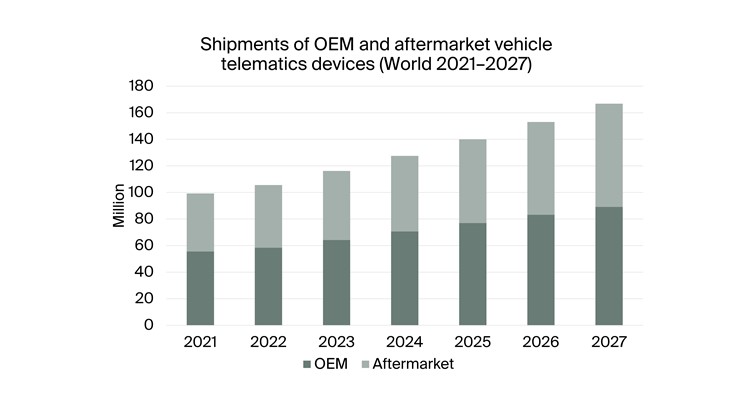Berg Insight last Tuesday released new findings about the vehicle telematics hardware market. More than 47.2 million aftermarket telematics devices were sold worldwide during 2022, corresponding to a market value of € 2.4 billion. The performance of the market was still affected by the COVID-19 pandemic and the following supply chain crisis, but the market has shown recovering signs in 2023. Until 2027, annual shipments of aftermarket telematics devices are forecasted to grow at a compound annual growth rate (CAGR) of 10.5 percent to reach 77.6 million at the end of the forecast period. Berg Insight estimates at the same time that global shipments of OEM telematics hardware for passenger cars, light trucks and commercial vehicles reached close to 58.4 million units in 2022 corresponding to a market value of € 8.4 billion. A combination of commercial and regulatory drivers now encourages a broader set of carmakers to expand availability of connected car services across geographies and market segments. There are also numerous OEM telematics offerings from commercial vehicle manufacturers. The attach rate of embedded telematics devices among passenger cars, light trucks and commercial vehicles is forecasted to increase from about 72 percent in 2022 to 93 percent in 2027.
The design and development of OEM telematics systems is complex as these have to integrate with vehicle systems, fulfil strict quality standards and ensure performance during the long lifecycle of a vehicle model. The suppliers of OEM telematics equipment are generally established automotive suppliers that develop their solutions in cooperation with car manufacturers. The leading OEM telematics hardware vendors in terms of unit shipments are therefore found in the passenger car and light truck segment. Examples of leading automotive suppliers of OEM telematics hardware include LG Electronics, Continental, Harman Marelli, Denso, Valeo, Actia, Lear, Bosch, Hyundai Mobis, Visteon and Aptiv.
Martin Cederqvist, IoT Analyst, Berg Insight
Berg Insight ranks Teltonika as the market leader in the aftermarket telematics hardware segment reaching telematics hardware sales of € 139 million. Other vendors that hold significant market shares are CalAmp, Queclink, Jimi (Concox) and ERM Advanced Telematics. These five vendors generated together approximately € 483 million in annual revenues from the sales of aftermarket telematics devices. CalAmp has transformed from a pure hardware provider to an end-to-end solution telematics provider. The company is however still a major supplier of hardware telematics and shipped 1.5 million units during 2022, corresponding to sales of € 105 million. Other significant aftermarket telematics hardware vendors include Sensata Insights, Positioning Universal and Danlaw from North America; Suntech International, Gosuncn RichLink, Neoway Technology, Gosafe, Kingwo, ATrack and iTriangle from Asia-Pacific; and the European vendors Meta System, Ruptela and Munic. Shipments of OEM telematics hardware for passenger cars and light trucks amounted to about 50.3 million in 2022, representing more than 86 percent of the total OEM telematics hardware shipments.


















